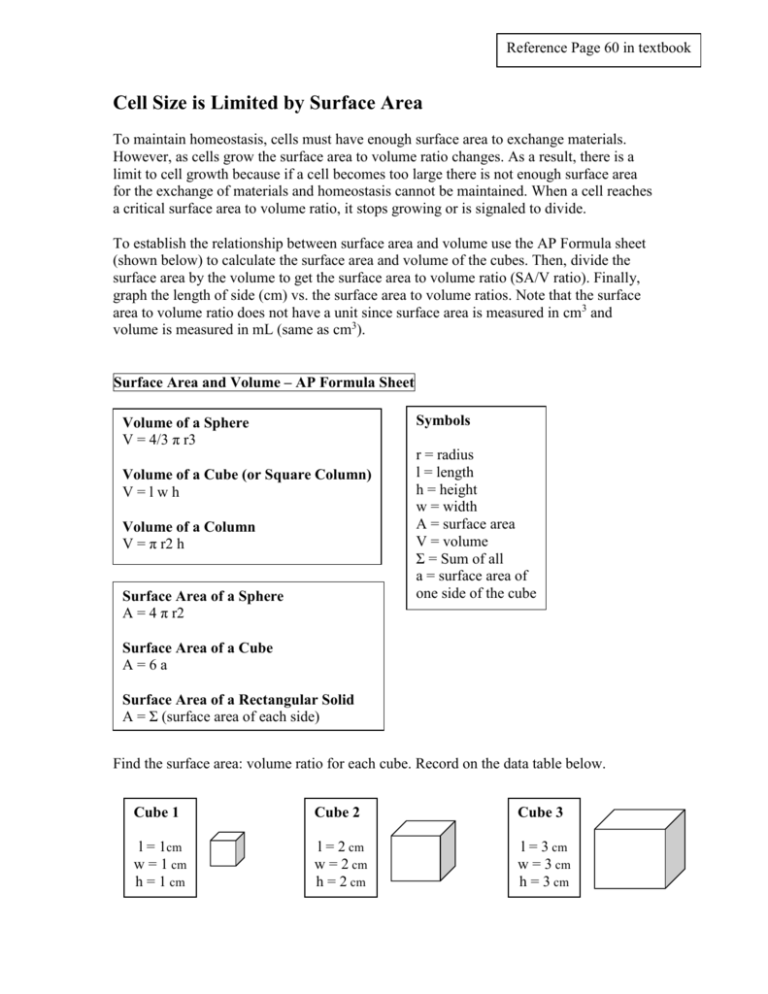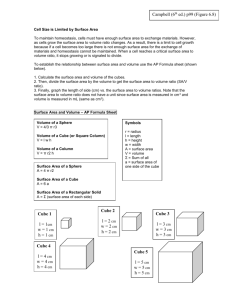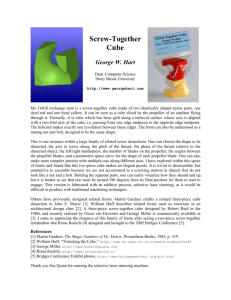Cell Size & Surface Area: Volume Ratio Worksheet
advertisement

Reference Page 60 in textbook Cell Size is Limited by Surface Area To maintain homeostasis, cells must have enough surface area to exchange materials. However, as cells grow the surface area to volume ratio changes. As a result, there is a limit to cell growth because if a cell becomes too large there is not enough surface area for the exchange of materials and homeostasis cannot be maintained. When a cell reaches a critical surface area to volume ratio, it stops growing or is signaled to divide. To establish the relationship between surface area and volume use the AP Formula sheet (shown below) to calculate the surface area and volume of the cubes. Then, divide the surface area by the volume to get the surface area to volume ratio (SA/V ratio). Finally, graph the length of side (cm) vs. the surface area to volume ratios. Note that the surface area to volume ratio does not have a unit since surface area is measured in cm3 and volume is measured in mL (same as cm3). Surface Area and Volume – AP Formula Sheet Symbols Volume of a Sphere V = 4/3 π r3 Volume of a Cube (or Square Column) V=lwh Volume of a Column V = π r2 h Surface Area of a Sphere A = 4 π r2 r = radius l = length h = height w = width A = surface area V = volume Σ = Sum of all a = surface area of one side of the cube Surface Area of a Cube A=6a Surface Area of a Rectangular Solid A = Σ (surface area of each side) Find the surface area: volume ratio for each cube. Record on the data table below. Cube 1 Cube 2 Cube 3 l = 1cm w = 1 cm h = 1 cm l = 2 cm w = 2 cm h = 2 cm l = 3 cm w = 3 cm h = 3 cm Cube 4 Cube 5 l = 4 cm w = 4 cm h = 4 cm l = 5 cm w = 5 cm h = 5 cm Cube 6 l = 6 cm w = 6 cm h = 6 cm Data Analysis Cube 1 2 3 4 5 6 Length of Cube Side (cm) SA / V Ratio of Cube Conclusion What is the relationship between size and surface area of a cube? Problems 1. Use the AP Formula sheet to calculate the following data values for the cells shown below. Surface area of the large cell. Surface area of a single small cell. Total surface area of all the small cells together. Surface area to volume ratio (SA/V) of the large cell. Surface area to volume ratio (SA/V) of one small cell. 2. Justify or refute the following statement based on the data values obtained for the cells above. “Numerous small cells are evolutionarily advantageous in regard to maintaining homeostasis in multi-cellular organisms” 3. 4. Which of the following cells has the greatest efficiency? Cell 1 Intestinal Endocrine Cell Cell 2 Brush Border Epithelium Cell with Microvilli Cell 3 Mucosal Epithelial Cell Section of aaplant Villusroot – an extension of the small intestinal wallhair cells. 5. The outer layer of may contain elongated cells called root Explain why this is an evolutionary advantage or disadvantage in terms of maintaining cellular homeostasis. In doing so, discuss how surface area to volume differs in root hair cells verses normal epithelial cells. 10 um







